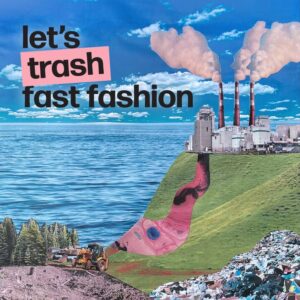The Impact of Fast Fashion on the Environment
What is Fast Fashion?
Fast fashion has a big negative impact on the environment. First, it creates a huge amount of waste. Millions of tons of clothes are thrown away each year, and many of these items sit in landfills for decades, polluting the earth.
Second, making these clothes uses a lot of water—often thousands of liters for just one pair of jeans. This water usage can lead to shortages in areas where water is already scarce. Plus, the chemicals used in dyeing and treating fabrics often end up in rivers, harming wildlife and local communities. Fast fashion also contributes to climate change. The production and transportation of these cheap clothes generate a lot of carbon emissions, making it a significant source of pollution.

What Can We Do?
To combat the negative impacts of fast fashion, we can take several meaningful steps. First, we should choose to support sustainable brands that prioritize ethical practices, eco-friendly materials, and fair labor conditions. Shopping second-hand is another excellent way to reduce waste while finding unique clothing. Additionally, buying fewer, high-quality items helps us invest in pieces that last longer and have a smaller environmental footprint. Taking care of our clothes by washing them properly and making repairs can also extend their lifespan. Educating ourselves and sharing this knowledge with others raises awareness about the issues surrounding fast fashion. Participating in clothing swaps, recycling or donating unwanted items, and supporting local businesses can further minimize waste and foster community.
Lastly, advocating for policies that promote sustainability in the fashion industry is crucial for driving systemic change. By making conscious choices in our shopping habits, we can contribute to a healthier planet and a more ethical fashion landscape.
Fast Fashion vs. Sustainable Fashion

Fast fashion refers to the rapid production of inexpensive clothing, allowing consumers to buy trendy items at low prices. This model prioritizes speed and cost, resulting in a high turnover of styles. While it makes accessible, it has significant downsides:
- Environmental Impact: Fast fashion contributes to massive waste, with millions of tons of clothing ending up in landfills each year. The production process uses vast amounts of water and energy and often involves harmful chemicals that pollute waterways.
- Labor Issues: Many fast fashion brands rely on cheap labor in developing countries, where workers often face poor conditions, long hours, and low wages.
- Quality and Longevity: Fast fashion items are usually of low quality, encouraging a throwaway culture. Consumers often replace items quickly, leading to increased waste.
Sustainable Fashion:
Sustainable fashion focuses on creating clothing in a way that is environmentally and socially responsible. It emphasizes quality over quantity, promoting ethical practices throughout the supply chain:
- Eco-Friendly Materials: Sustainable fashion often uses organic, recycled, or upcycled materials, minimizing environmental impact.
- Ethical Labor Practices: Brands committed to sustainability prioritize fair wages, safe working conditions, and respect for workers’ rights.
- Longevity and Timelessness: Sustainable fashion promotes durable designs and encourages consumers to invest in pieces that will last, reducing the need for frequent replacements.
Circular Economy: Many sustainable brands advocate for a circular approach, encouraging recycling, repairing, and upcycling clothing to extend its life cycle.

The Psychology of Fast Fashion: Why We Buy
Fast fashion has become a dominant force in the retail industry, largely driven by psychological factors that influence consumer behavior. Understanding these motivations can shed light on why so many of us are drawn to inexpensive, trendy clothing.
1. Instant Gratification
Fast fashion offers immediate access to the latest trends at low prices, satisfying our desire for instant gratification. In a world where we seek quick rewards, the ability to purchase new clothes on a whim provides a quick emotional boost.
2. Social Comparison
Social media plays a significant role in shaping our perceptions of fashion. Seeing influencers and peers wearing the latest styles can create a sense of urgency to keep up. This social comparison drives us to buy more to feel accepted or valued within our social circles.
3. FOMO (Fear of Missing Out)
Fast fashion brands capitalize on FOMO by constantly introducing new collections and limited-time offers. The fear of missing out on a trendy item encourages consumers to purchase quickly, often leading to impulse buying.
4. Low Cost and High Volume
The affordability of fast items means that consumers can buy more for less. This perception of value encourages bulk purchasing, leading to a wardrobe filled with items that are rarely worn.
Conclusion
